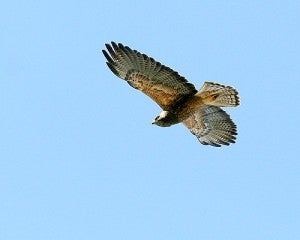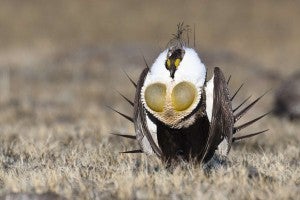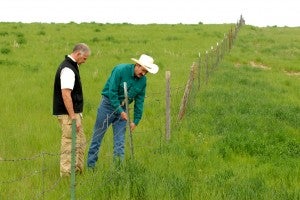
A raptor adapted to the open grasslands, the Swainson’s hawk has become increasingly dependent on agriculture in California, especially alfalfa crops, as native communities are converted to agricultural lands.
The 2014 State of the Birds report, released this week, sends a message that is both somber and hopeful: we can bring vulnerable bird species back from the brink of extinction, but there is a lot of work to be done.
While some once-abundant species have rebounded in response to habitat restoration and management, others continue to decline. If we want to put our nation’s birds on a path to recovery, farmers and ranchers have a critical role to play.
Success stories show the way
Iconic bird species like bald eagles, brown pelicans and peregrine falcons that were once teetering on the edge of extinction are thriving again. California condors, with their spectacular 10-foot wingspans, went extinct in the wild in 1987. Today, 225 individuals soar once again over several western states.
With the right conservation investments and habitat management in place, some wetland species are making remarkable turnarounds. Twenty million acres of wetland habitat have been restored for waterfowl species like mallard and gadwall, which can now be hunted sustainably. Meanwhile, waterfowl migrations along the California Central Valley and Mississippi River flyways are returning to their former glory as a result of programs designed to protect wetland habitat, such as Wetlands Reserve Program projects on private lands and the North American Wetlands Conservation Act.

The greater sage-grouse, an icon of the energy-rich sagebrush deserts across 11 Western states, is poised to lose 71 percent of its breeding range by 2080.
Unfortunately, some species, like the eastern meadowlark, are disappearing with the loss of American farmlands, and several species of grouse that depend heavily on ranch lands are sliding toward extinction. Key pieces of legislation like the Farm Bill and related conservation programs have made strides toward habitat conservation on private lands, but declines continue.
Unlocking the potential of agriculture
The State of the Birds report calls out the need for more large-scale habitat enhancement initiatives for birds in the most threatened ecosystems, such as western aridlands and grasslands, which face intense pressure from development and drought. The best hope for many birds in these ecosystems – species like the lesser prairie-chicken, greater sage-grouse and Swainson’s hawk in California’s Central Valley – lies in the region’s vast tracts of agricultural lands. In fact, with the right landowner incentives for habitat conservation in place, these declining species can prosper once again.
Ranching birds, farming habitat

There are a range of conservation activities that landowners can adopt to produce credits under a habitat exchange, from managed grazing to prescribed fires.
EDF is working in partnership with agricultural associations (Colorado Cattlemen’s Association, Plains Cotton Growers, and Farm Bureaus in California, Texas, Oklahoma and Kansas, to name a few) to launch habitat exchanges that unlock the potential of agriculture to grow bird habitat alongside crops and pastures. Exchanges provide a mechanism for farmers and ranchers to get paid for stewarding at-risk bird habitat by conservation investors and industries that are required by law to mitigate their development impacts.
We have an opportunity right now to reverse habitat loss and species declines on America’s farms and ranches while maintaining a robust agricultural economy. It is not only possible, but utterly necessary to restore bird populations while sustaining revenue for America’s farmers and ranchers.
Together, we can improve the state of the birds, and keep the state of America’s agriculture strong.










One Comment
I think you can get a lot from farmers that way rather than recent attempts by some pressure groups to file citizen suits against regulatory bodies which in turn then enjoin farmers and force them to settle out of court in cases they might have won had they had the funds. In the end the farmer gives up his land and without him often wildlife biodiversity suffers further.